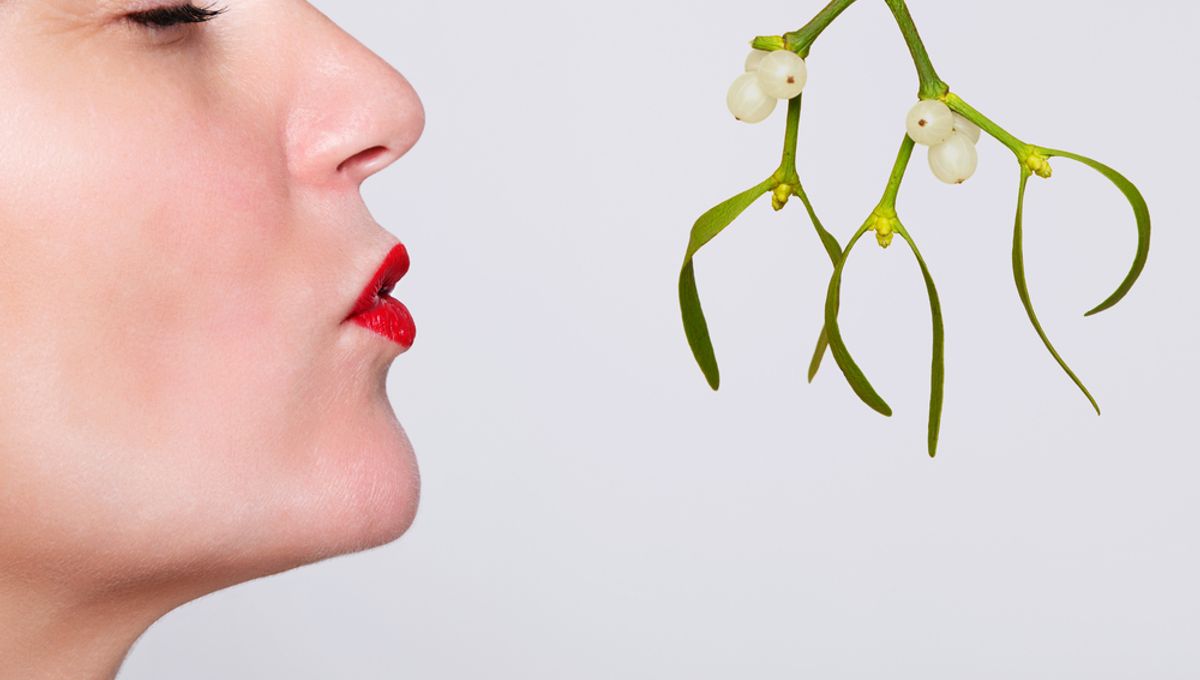
Are you ready for the romantic Christmas tradition of kissing under the dung-on-a-twig? No? We don’t blame you – the probable origins of mistletoe’s name aren’t particularly alluring. The parasitic plant has been with us for thousands to even millions of years, weaving its way into trees and traditions alike on every continent apart from Antarctica.
Mistletoe berries (actually drupes) contain a strong cellulose-based biological adhesive called viscin, making them incredibly sticky. In fact, one recent study has explored how viscin could be used as a biodegradable and biorenewable adhesive in biotechnology. “When my daughter was playing with a berry from a mistletoe we bought from a local Christmas market, and it started sticking to everything, I was intrigued,” senior author of the paper Matthew Harrington said in a statement.
Their super-sticky goop lets mistletoe seeds adhere to the tree branches the plant grows on. They get there with a little help from their animal friends. Some seeds are deposited after sticking to beaks or fur, getting wiped off onto a tree branch by the unsuspecting critters.
Others pick an even less glamorous route, getting pooped out by birds onto their new home. One aptly-named species that does this is the Australian Mistletoebird (Dicaeum hirundinaceum), with a digestive system perfectly suited to this purpose. For example, they don’t have a gizzard, which usually grinds up food, meaning the berries pass through relatively unscathed.
“Within a few minutes, the bird passes the entire seed through the digestive tract,” plant evolution expert Daniel Nickrent told Smithsonian Magazine. “It wiggles its little behind, attaching the mistletoe seed to the branch of the tree.”
The dwarf mistletoe spreads via explosion, with water pressure building up inside the berry until it pops and propels seeds up to 15 meters (50 feet). An unnamed researcher told the United States Geological Survey that “if you put ripe berries in a paper bag and shake it, it sounds just like popping popcorn.”
Once the seeds get to where they need to be, they set about wiring themselves into the tree with their root-like haustorium. This both anchors them in place and allows them to tap into their host’s sweet sweet nutrient and water supply. Despite this, mistletoe isn’t actually a full parasite – it is, in fact, what is known as a “hemi-parasite”. Mistletoe is an evergreen plant, with leaves capable of photosynthesis, meaning that they can make a little extra energy for themselves alongside what is siphoned off their host.
This parasitic relationship can weaken host trees, but doesn’t usually kill them. However, some mistletoes are considered pests, and excessive growth can harm the tree. According to Mistletoe Matters, mistletoe being evergreen, thus keeping its leaves, means that hosts may be buffeted around more in winter storms. It can also affect how hosts exchange gas and water, impacting photosynthesis. Large haustorium can also cause the ends of branches to become stunted or die.
However, it’s not all bad news. Unlike host trees, mistletoe doesn’t really bother taking back nutrients from its leaves before letting them fall to the ground. Instead, evergreen mistletoe leaves descend nutrients and all, feeding the ecosystem below throughout the year. Birds also use mistletoe as a winter food source and nesting material.
As for the festive tradition of kissing under the mistletoe, origins are murky. Some link it to the traditions of Celtic Druids. Some trace it back to the Nordic myth of Odin and Frigg’s son Baldur, who was killed by Loki using a weapon made of mistletoe. According to the legend, Baldur was revived, and Frigg declared the plant a symbol of love.
However, others claim that the tradition actually only dates back to servants in 18th century England, gaining popularity in the 19th century in the US and England. Historian Mark Forsyth told TIME that “Baldur’s death involves mistletoe, but it’s got nothing to do with kissing or Christmas.” The earliest reference to the practice Forsyth could find was a song from 1784.
According to the English tradition, any woman caught under the mistletoe must accept smooches from men or risk bad luck. Some plucked a berry from the plant for every peck given.
No matter how romantic you find this parasitic poop plant, the berries and leaves aren’t very good for you, containing viscotoxins and phoratoxins. Eating it can cause gastrointestinal issues, so steer clear of nibbling any as a post-kiss snack.
Source Link: The Not-So-Romantic Science Of Mistletoe